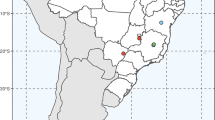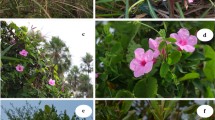Summary
With more than 1,200 species, Ruellieae is a taxonomically and ecologically diverse tribe in the Acanthaceae. In recent years, numerous morphological and phylogenetic studies have contributed important new information about species belonging to this tribe, yet basic anatomical knowledge of lineages within Ruellieae is relatively scarce. The objective of the present study is to help close this anatomical knowledge gap through comparative leaf and stem anatomical study of 14 species representative of all seven subtribes within Ruellieae. We document relative conservatism in leaf and stem anatomy except that unifacial leaves characterise a few taxa and have evolved a minimum number of three times in the tribe. Cystoliths were found abundantly in both leaf and stem tissue; these were oriented in two different directions in leaves while in stems only one orientation was found. Finally, we discuss the putative presence of a stem and petiole endodermis in several taxa studied. These data serve as a starting point for further comparative anatomical studies within Ruellieae and other Acanthaceae.


Similar content being viewed by others
References
Ahmad, K. J. (1975). Cuticular studies in some species of Lepidagathis and Barleria. Bot. Gaz. 136: 129 – 135.
Amirul-Aiman, A. J., Noraini, T., Nurul-Aini, C. A. C. & Ruzi, A. R. (2013). Petal anatomy of four Justicia (Acanthaceae) species. AIP Conference Proceedings 1571: 368 – 371.
Aoyama, E. M. & Indriunas, A. (2012). Leaf anatomy of Justicia brandegeana Wassh. & L. B. Sm. (Acanthaceae). Commun. Pl. Sci. 2: 37 – 39.
Bauer, P., Elbaum, R. & Weiss, I. M. (2011). Calcium and silicon mineralization in land plants: transport, structure and function. Pl. Sci. 180: 746 – 756.
Callmander, M. W., Tripp, E. A. & Phillipson, P. B. (2014). A new name in Ruellia L. (Acanthaceae) for Madagascar. Candollea 69: 81 – 83.
Carine, M. A. & Scotland, R. W. (2002). Classification of Strobilanthinae (Acanthaceae): Trying to classify the unclassifiable? Taxon 51: 259 – 279
Carlquist, S. (2001). Comparative Wood Anatomy: Systematic, Ecological, and Evolutionary Aspects of Dicotyledon Wood. Springer-Verlag, Berlin.
Columbus, J. T. (1999). Morphology and leaf blade anatomy suggest a close relationship between Bouteloua aristidoides and B. (Chondrosium) eriopoda (Graminae: Chloridoideae). Syst. Bot. 23: 467 – 478.
Daniel, T. F. (1990). New, recognised, and little-known Mexican species of Ruellia (Acanthaceae). Contr. Univ. Mich. Herb. 17: 139 – 162
Esau, K. (1953). Plant Anatomy. John Wiley & Sons, Inc., New York.
Ezcurra, C. E. (1993). Systematics of Ruellia (Acanthaceae) in Southern America. Ann. Missouri Bot. Gard. 80: 787 – 845.
Gal, A., Brumfeld, V., Weiner, S., Addadi, L. & Oron, D. (2012). Certain biominerals in leaves function as light scatterers. Advanced Materials 24: OP77 – O83.
Holm, T. (1907). Ruellia and Dianathera: an anatomical study. Bot. Gaz. 43: 308 – 329.
Inamdar, J. A., Chaudhari, G. S. & Ramana Rao, T. V. (1990). Studies on the cystoliths of Acanthaceae. Feddes Repert. 101: 417 – 424.
Iyyappan, C. & Mounnissamy, V. M. (2011). Microscopical study of plant “Dipteracanthus prostratus Poir — Acanthaceae”. Int. J. Pharm. Bio. Sci. 2: 358 – 366.
Kuo-Huang, L. L. & Yen, T. B. (1996). The development of lithocysts in the leaves and sepals of Justicia procumbens L. Taiwania 42: 17 – 26.
Leroux, O. (2012). Collenchyma: a versatile mechanical tissue with dynamic cell walls. Ann. Bot. 110: 1083 – 1098.
Lersten, N. S. (1997). Occurrence of endodermis with a casparian strip in stem and leaf. Bot. Rev. (Lancaster) 63: 265 – 272.
Manktelow, M. (1996). Phaulopsis (Acanthaceae) — a monograph. Symb. Bot. Upsal. 31: 1 – 183.
____ (2000). The filament curtain: a structure important to systematics and pollination biology in the Acanthaceae. Bot. J. Linn. Soc. 133: 129 – 160.
McDade, L. A., Daniel, T. F., Masta, S. E. & Riley, K. M. (2000). Phylogenetic relationships within the tribe Justicieae (Acanthaceae): evidence from molecular sequences, morphology, and cytology. Ann. Missouri Bot. Gard. 87: 435 – 458.
____ & Tripp, E. A. (2007a). Synopsis of Costa Rican Ruellia L. (Acanthaceae), with descriptions of four new species. Brittonia 59: 199 – 216.
____ & ____, with assistance from T. F. Daniel (2007b). Acanthaceae of La Selva Biological Station, Costa Rica. In: La Flora Digital de La Selva. pdf available at http://clade.acnatsci.org/mcdade/
____, Daniel, T. F. & Kiel, C. A. (2008). Toward a comprehensive understanding of phylogenetic relationships among lineages of Acanthaceae s.l. (Lamiales). Amer. J. Bot. 95: 1136 – 1152.
Metcalfe, C. R. & Chalk, L. (1950). Anatomy of Dicotyledons (First ed., Vol. 1). Oxford University Press, London.
Monteiro, M. M. & Aoyama E. M. (2012). Effects of different light conditions on leaf anatomy of Ruellia furcate (Nees) Lindau (Acanthaceae). Commun. Pl. Sci. 2: 45 – 47.
Moylan, E. C., Bennett, J. R., Carine, M. A., Olmstead, R. G. & Scotland, R. W. (2004a). Phylogenetic relationships among Strobilanthes s.l. (Acanthaceae): evidence from ITS nrDNA, trnL-F cpDNA, and morphology. Amer. J. Bot. 91: 724 – 735.
____, Rudall, P. J. & Scotland, R. W. (2004b). Comparative floral anatomy of Strobilanthinae (Acanthaceae), with particular reference to internal partitioning of the flower. Pl. Syst. Evol. 249: 77 – 98.
Muhaidat, R., McKown, A. D., Khateeb, W. A., Al-Shreideh, M., Domi, Z. B., Hussein, E. & El-Oqlah, A. (2012). Full assessment of C4 photosynthesis in Blepharis attenuata Napper (Acanthaceae) from Jordan: evidence from leaf anatomy and key C4 photosynthetic enzymes. Asian J. Pl. Sci. 2012: 1 – 11.
Ocampo, G. & Columbus, J. T. (2010). Molecular phylogenetics of suborder Cactineae (Caryophyllales), including insights into photosynthetic diversification and historical biogeography. Amer. J. Bot. 97: 1827 – 1847.
Okazaki, M., Setoguchi, H., Aoki, H. & Suga, S. (1986). Application of soft x-ray microradiography to observation of cystoliths in the leaves of various higher plants. Bot. Mag. (Tokyo) 99: 281 – 287.
O’Neill, C. S. (2010). Anatomy of the shrimp plant, Justicia brandegeana (Acanthaceae). Studies by Undergraduate Researchers at Guelph 3: 41 – 47.
Paopun, Y., Umrung, P., Thanomchat, P. & Kongpakdee, C. (2011). Epidermal surface and leaf anatomy of Thunbergia laurifolia Lindl. J. Microsc. Soc. Thailand 4: 61 – 64.
Patil, A. M. & Patil, D. A. (2011). Occurrence and significance of cystoliths in Acanthaceae. Curr. Bot. 2: 1 – 5.
____ & ____ (2012). Petiolar anatomy of some hitherto unstudied Acanthaceae. J. Exp. Sci. 3: 5 – 10.
Philpott, J. (1953). A blade tissue study of leaves of forty-seven species of Ficus. Bot. Gaz. 115: 15 – 35.
Remadevi, S., Vinesh, R. & Binoj Kumar, M. S. (2006). Stem anatomy of Acanthaceae and its taxonomic significance. J. Econ. Taxon. Bot. 30: 453 – 468.
Schmidt-Lebuhn, A. (2003). A taxonomic revision of the genus Suessenguthia Merxm. (Acanthaceae). Candollea 58: 101 – 128.
____ & Tripp, E. A. (2009). Ruellia saccata (Acanthaceae), a new species from Bolivia. Novon 19: 515 – 519.
Scotland, R. W. (1991). A systematic analysis of pollen morphology of Acanthaceae genera with contorted corollas. Pollen & Spores 44: 269 – 289.
____ & Vollesen, K. (2000). Classification of Acanthaceae. Kew Bull. 55: 513 – 589.
Setoguchi, H., Okazaki, M. & Suga, S. (1989). Calcification in higher plants with special references to cystoliths. Pp. 409 – 418 In: Origin, Evolution, and Modern Aspects of Biomineralization in Plants and Animals. Plenum Press, New York.
Sharman, B. C. (1943). Tannic acid and iron alum with safranin and orange G in studies of the shoot apex. Stain Technol. 18: 105 – 111.
Stanfield, R. (2013). The physiological significance of calcium carbonate cystoliths: can these structures sequester heavy metals? M.A. Thesis, California Polytechnic State University, Pomona.
Tripp, E. A. (2004). The current status of Ruellia (Acanthaceae) in Pennsylvania: two endangered/threatened species. Bartonia 62: 55 – 62.
____ (2007). Evolutionary relationships within the species-rich genus Ruellia (Acanthaceae). Syst. Bot. 32: 628 – 649.
____ (2010). Taxonomic revision of Ruellia sect. Chiropterophila (Acanthaceae): a lineage of rare and endemic species from Mexico. Syst. Bot. 35: 629 – 661.
____, Daniel, T. F., Lendemer, J. C. & McDade, L. A. (2009). New molecular and morphological insights prompt transfer of Blechum to Ruellia (Acanthaceae). Taxon 58: 893 – 906.
____, ____, Fatimah, S. & McDade, L. A. (2013a). Phylogenetic relationships within Ruellieae (Acanthaceae), and a revised classification. Int. J. Pl. Sci. 174: 97 – 137.
____ & Dexter, K. G. (2012). Taxonomic novelties in Namibian Ruellia (Acanthaceae). Syst. Bot. 37: 1023 – 1030.
____ & Fatimah, S. (2012). Comparative anatomy, morphology, and molecular phylogenetics of the African genus Satanocrater (Acanthaceae). Amer. J. Bot. 99: 967 – 982.
____, ____, Darbyshire, I. & McDade, L. A. (2013b). Origin of African Physacanthus (Acanthaceae) Via Wide Hybridization. PLoS ONE 8: e55677.
____ & Koenemann, D. M. (in press). Nomenclatural synopsis of the genus Sanchezia (Acanthaceae). Novon.
____ & Manos, P. S. (2008). Is floral specialization an evolutionary dead-end? Pollination system evolution in Ruellia (Acanthaceae). Evolution 62: 1712 – 1737.
____ & McDade, L. A. (2012). New synonymies for Ruellia (Acanthaceae) of Costa Rica and notes on other neotropical species. Brittonia 64: 305 – 317.
____ & ____ (2014a). A rich fossil record yields calibrated phylogeny for Acanthaceae (Lamiales) and evidence for marked biases in timing and directionality of intercontinental disjunctions. Syst. Biol. 63 (5): 660 – 684.
____ & ____ (2014b). Time-calibrated phylogenies of hummingbirds and hummingbird-pollinated plants reject hypothesis of diffuse co-evolution. Aliso 31: 89 – 103.
Vollesen, K. (2006). Taxonomic revision of the genus Duosperma (Acanthaceae). Kew Bull. 61: 289 – 351.
Wasshausen, D. C & Wood, J. R. I. (2003). The genus Dyschoriste (Acanthaceae) in Bolivia and Argentina. Brittonia 55: 10 – 18.
Watt, W. M., Morrell, C. K., Smith, D. L. & Steer, M. W. (1987). Cystolith development and structure in Pilea cadierei (Urticaceae). Ann. Bot. 60: 71 – 84.
Wu, C. C. & Kuo-Huang, L. L. (1997). Calcium crystals in the leaves of some species of Moraceae. Bot. Bull. Acad. Sin. 38: 97 – 104.
Acknowledgements
We thank Rancho Santa Ana Botanic Garden for welcoming our research in their anatomy lab. We are grateful to Travis Columbus (RSABG) for helpful discussions on anatomy and Manual Lujan (RSABG) for assistance in preparing vouchers from living material. Two anonymous reviewers contributed important comments that improved this manuscript. Finally, we thank the National Science Foundation (NSF-DEB Award #0919594 and NSF-DEB Award #1354963 to Erin Tripp and Lucinda McDade) for funding this research and for funding the second author’s participation in RSABG’s Summer Research Institute training program.
Author information
Authors and Affiliations
Corresponding author
Rights and permissions
About this article
Cite this article
Tripp, E.A., Fekadu, M. Comparative leaf and stem anatomy in selected species of Ruellieae (Acanthaceae) representative of all major lineages. Kew Bull 69, 9543 (2014). https://doi.org/10.1007/s12225-014-9543-8
Accepted:
Published:
DOI: https://doi.org/10.1007/s12225-014-9543-8




